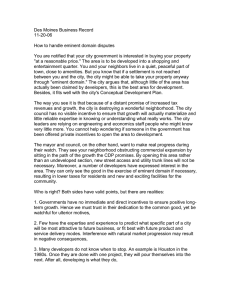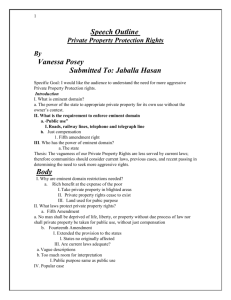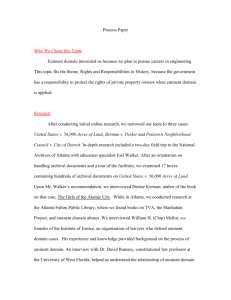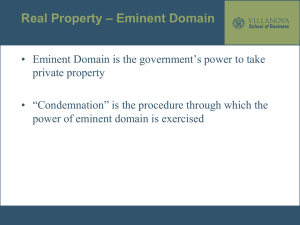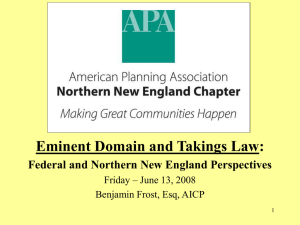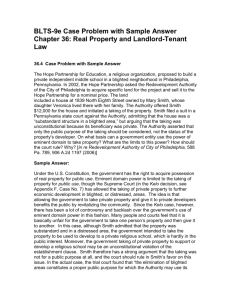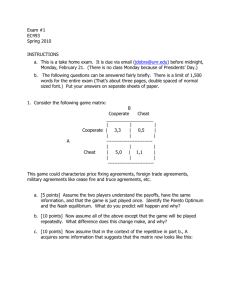The Kelo Decision
advertisement
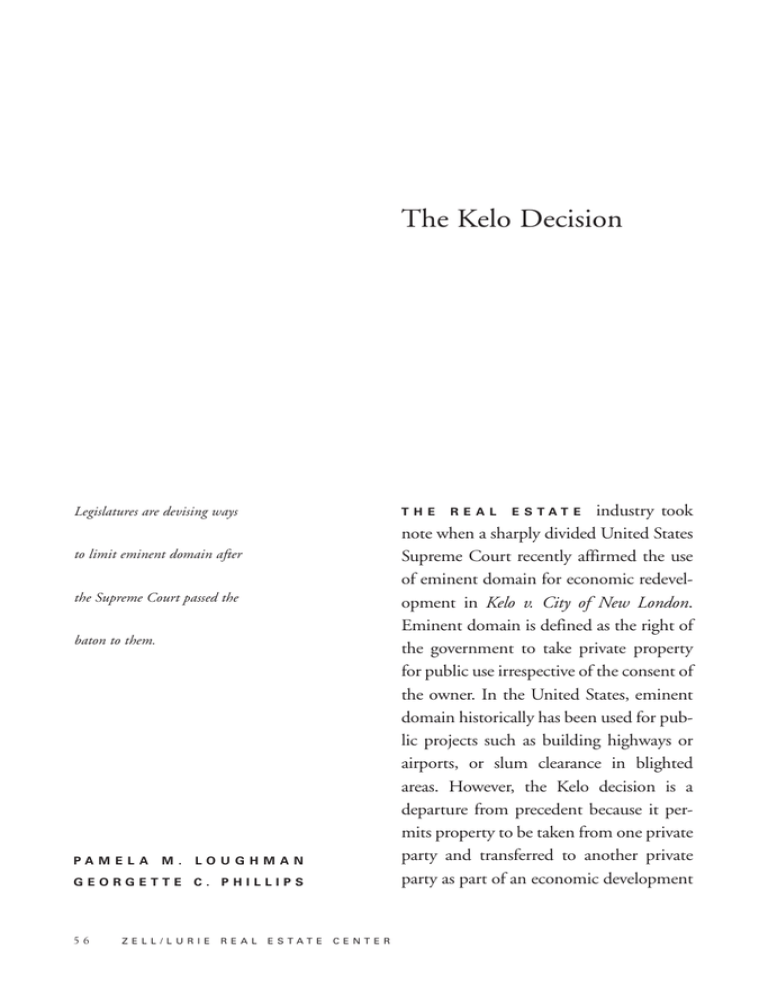
The Kelo Decision T H E R E A L E S T A T E industry took note when a sharply divided United States Supreme Court recently affirmed the use of eminent domain for economic redevelopment in Kelo v. City of New London. Eminent domain is defined as the right of the government to take private property for public use irrespective of the consent of the owner. In the United States, eminent domain historically has been used for public projects such as building highways or airports, or slum clearance in blighted areas. However, the Kelo decision is a departure from precedent because it permits property to be taken from one private party and transferred to another private party as part of an economic development Legislatures are devising ways to limit eminent domain after the Supreme Court passed the baton to them. PA M E L A M. LOUGHMAN GEORGETTE C. PHILLIPS 56 ZELL/LURIE REAL ESTATE CENTER plan. This expands the meaning of “public use,” from providing direct benefits to the public, to include indirect advantages, such as jobs from a private employer and increased tax revenues. The Supreme Court majority reasoned that this type of taking is constitutionally permissible because the “public use” criteria of the Fifth Amendment’s takings clause is satisfied by the public purpose of the economic development plan, even if the condemned property will not be available to the general public after it is developed. The decision cited a longstanding policy of judicial deference to legislative judgments as to what public needs justify the use of eminent domain powers, and rejected a proposed bright-line rule that economic development does not qualify as a public use. But the majority left open the possibility that such a rule can be enacted by a legislative body, stating “nothing in our opinion precludes any State from placing further restrictions on its exercise of the takings power.” EMINENT DOMAIN How common is the use of eminent domain for economic development? According to the Institute for Justice, which describes itself as a “public interest advocate for economic liberty,” and represented the plaintiff/property owner in the Kelo case, there were 10,000 actual or threatened condemnations in the United States from 1998 to 2003. During the same five-year period, however, there were merely 91 reported court decisions on this issue nationwide. Urban renewal projects often depend on eminent domain to acquire land. Irrespective of how such incidents are counted, their numbers are expected to rise following the green light given by the Supreme Court—at least until new legislation curtailing eminent domain is in place. In addition to legislative roadblocks, there are economic reasons why eminent domain should be considered a last resort for municipalities and developers. It is more expensive to acquire property through a taking than through voluntary exchange on the free market. Although the government is constitutionally required to pay only “fair and just compensation” (interpreted as fair market value before development), there are procedural requirements that increase transaction costs and create project delays, increasing the ultimate cost of the property. These expensive procedural requirements are in addition to costly delays resulting from legal challenges. Local opposition to eminent domain should not be underestimated. Municipalities and developers increasingly find they have taken on an entire community rather than individual REVIEW 57 property owners in a contested taking. Grassroots community groups, sometimes aided by property-rights advocates, have a powerful organizing tool in Internet virtual communities for disseminating information on websites, email and blogs, as well as galvanizing opposition with online petitions. Public meetings televised on cable television channels notify the public of proposed takings, and provide a platform to opposition groups that testify at such meetings. Litigation often results when the taking is approved at the local level. The increased bargaining power of local opposition corresponds to increased costs and delays for all. Before resorting to the stick of eminent domain as a redevelopment tool, several carrots may entice property owners to sell. Public relations campaigns to introduce a redevelopment plan can minimize ill will among property owners and avoid the affront resulting from an official letter summarily announcing a taking without prior warning. The developer/municipality may offer to relocate businesses and homes within the existing community to reduce the sense of dislocation that property owners may experience. Increasing the compensation offered to more than market value may also spur sales with private property owners. Of course, there may be holdouts who refuse to sell their property under any circumstances. In such cases, local 58 ZELL/LURIE REAL ESTATE CENTER government may have no choice but to proceed with a taking. THE PUBLIC REACTION The Kelo dissent written by Justice O’Connor argued “[t]he specter of condemnation hangs over all property. Nothing is to prevent the state from replacing any Motel 6 with a Ritz-Carlton, any home with a shopping mall, or any farm with a factory.” As it turned out, the four dissenting judges were better attuned to the public’s skepticism about the power of the government to take property than the majority. The public response to the Kelo decision was overwhelmingly negative. Both conservatives (who champion property rights) and liberals (concerned about property owners in marginal areas) condemned the use of eminent domain in widespread media coverage. Polls found that 90 percent of the public opposed the practice of eminent domain for private economic uses. Activists proposed “taking” the homes of two Supreme Court Justices who supported the decision. Perhaps the most surprising response was Supreme Court Justice Stevens (who voted with the majority) publicly stating that if he were a legislator he would oppose eminent domain as a tool for economic development. Following the Kelo decision, politi- Table I: Types of Legislation, Legislative Stages and States STAGE OF LEGISLATION introduced in committee enacted failed IL, OH CA, NJ, NY, PA, AL, CO, KS, ME, MI, NE, OK, SC, VT, VI, DE, TX MN, OR NY, MI, PA, WI, AL, OK AL Types of State Legislation Stated Public Purpose Restricted to Blighted Properties Enhanced Public Notice NY Local Government Approval NY Moratorium on Eminent Domain CA Compensation to Property Owner MI, NY Other OK, SC, VI cians in 23 states proposed legislation to curb or ban the use of eminent domain. According to the National Conference of State Legislatures, different methods have been proposed to curb eminent domain, such as heightening the standard for “public use,” making it more difficult or impossible to take private property for economic development. Another approach is to limit the use of eminent domain for economic development to blighted properties while explicitly defining blight. Other proposals call for increasing the notice given to potentially affected property owners and requiring good faith negotiation before proceeding with a taking. Some legislation calls for setting compensation formulas that pay more than the fair market value of the property, while other proposals require supermajority voting approval. The success of recent eminent domain legislation in various states is summarized in Table I. OH MN Legislation with similar aims is pending at the federal level, where in 2005 ten bills were introduced in the House and three in the Senate. The House passed legislation that denies federal funding to any state or municipal project using eminent domain to compel the sale of private property for economic development purposes. The Kelo decision recognizes that while eminent domain is here to stay, the exact form it will take is legislative rather than judicial. Ultimately, the battle over eminent domain begs the question of how comfortable the public is with the intersection of government and private development. Given the public response to the Supreme Court’s ruling in Kelo, the answer is “not very.” REVIEW 59
